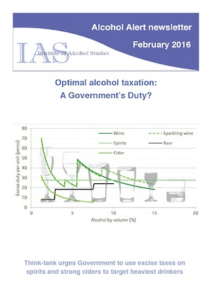In this month’s alert
Editorial – February 2016
Welcome to the February 2016 edition of Alcohol Alert, the Institute of Alcohol Studies newsletter, covering the latest updates on UK alcohol policy matters.
In this issue, the Institute of Fiscal Studies urges the UK Government to use duty on spirits and strong ciders to reduce alcohol-related harm among the heaviest drinkers, and University of Sheffield experts’ models see minimum unit pricing as a viable option too. Other articles include: Number of alcohol-related deaths creeps upwards, as the number of drink-drive deaths reaches a crossroads, and Dame Sally Davies defends the new alcohol unit guidelines.
Please click on the article titles to read them. We hope you enjoy this edition.
Think-tank urges Government to use duty on spirits and strong ciders to target heaviest drinkers
It’s time to think seriously about the structure of excise duties, argues the Institute for Fiscal Studies
Reforming taxes to increase in line with alcohol strength will more accurately target heavy drinkers, says the Institute of Fiscal Studies (IFS).
In this year’s Green Budget – a comprehensive assessment of the state of the public finances – the respected economic think tank singled out alcohol taxes as being very badly targeted at the social harms caused by alcohol consumption, because they charge very different rates of tax on the same alcohol content depending on the form in which it is consumed.
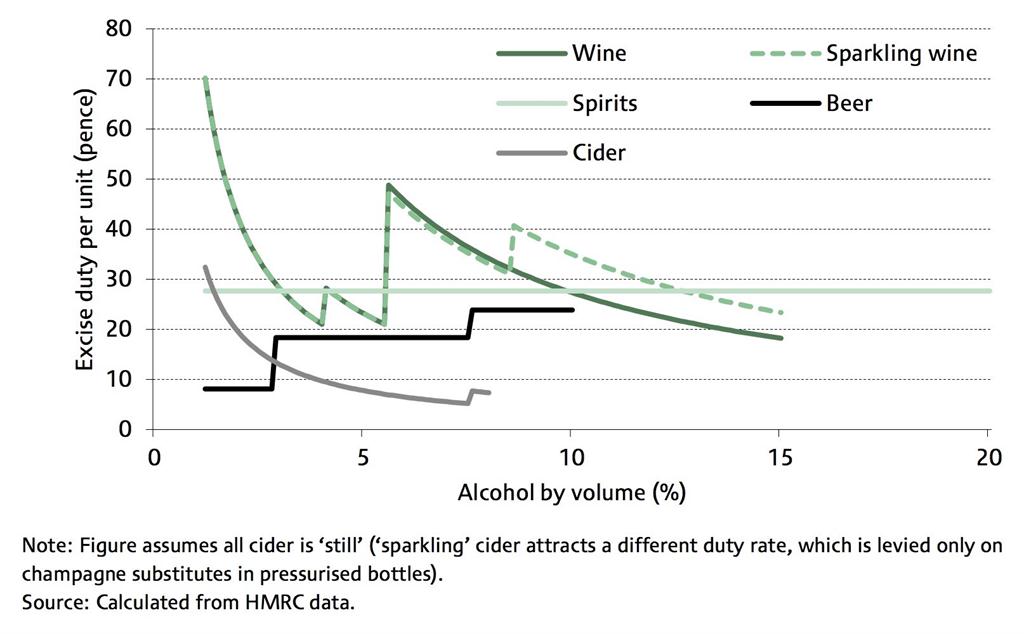
The excise duty on a litre of 7.5% strength cider is currently 39p, significantly cheaper than a litre of beer of the same strength, which attracts a duty of £1.38. Using this example, the report’s authors suggest that the Government should “sort out these anomalies in duty rates and to reverse the long-term trend to lower duties on spirits, which are disproportionately consumed by heavy drinkers.”
Where we are now and why
Having accounted for more than one pound in ten of tax revenues at the end of the 1970s, revenues from existing duties (road fuel, tobacco and alcohol) are forecast to account for just 6% by 2020-21, down from 7.2% now. The IFS calculates that “had these duties maintained their 1978-79 share of national income, they would be raising £26 billion more than they currently raise.”
According to the IFS index of real alcohol duties since 1979 (see below), beer duty peaked in 1985-86 before falling back to a level that today, in real terms, is around 4% higher than in 1978-79. For wine and spirits, the broad trend has been a decline in real duties. Today, real wine duty is now just 73% of its 1978-79 level and for spirits the duty level is now only 51% of the 1978-79 level.
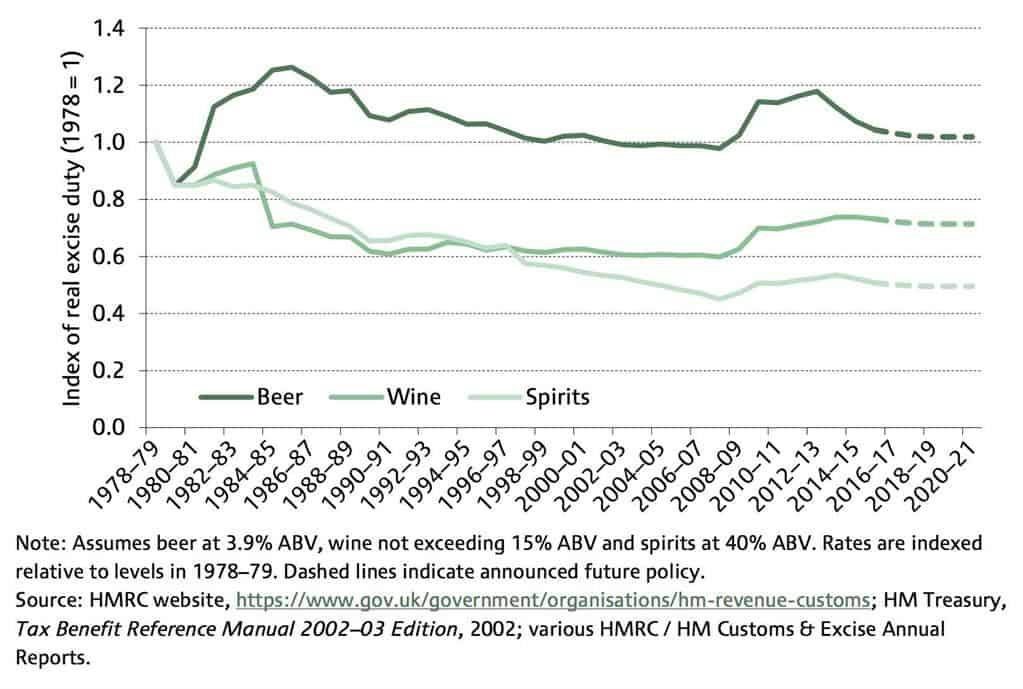
The corrective purpose of alcohol taxation
Noting that “it is often the abusive behaviour associated with some consumers’ consumption episodes that creates problems”, the IFS sets out an argument for setting alcohol duties in line according to “the marginal social damage caused” by the heaviest drinkers, who are most prone to abusive behaviour. The notion of using alcohol taxes as a corrective tool accounts for the social harms of alcohol consumption above that of a simple revenue raising objective, in which a government would normally aim to set a tax rate no higher than the level at which revenue from the tax is maximised (the ‘Laffer’ rate).
Instead, in the case of alcohol, the marginal effects of every next drink are “likely to be highly non-linear: while for a smoker the next cigarette of the day is roughly as damaging as the first, the tenth pint of beer in an evening is likely to cause much more harm than the first.
“This creates challenges both in quantifying the marginal… costs of alcohol consumption, and hence the appropriate tax level, and in designing a tax structure that effectively targets the most harm-inducing consumption,” explain the authors.
The IFS suggests that although taxes per unit of alcohol should be the same regardless of the form of drink, “if abusive drinkers tend to consume more of their alcohol units in concentrated form (as, for instance this allows for more rapid alcohol consumption) or alcohol with any other identifiable characteristic, then there is a case for taxing this form of alcohol more strongly.”
Regressive taxation: It’s not what you earn, it’s how you spend it
One finding of the report challenged the oft-repeated argument from industry that alcohol taxes disproportionately affect those on the lowest incomes. The IFS report countered that a better way of assessing the distributional effect of these taxes would be to consider the shares of total spending devoted to these items, not income. As Figure 9.4 in the report shows (below), for the bottom 80% of spenders, “the share spent on alcohol tends to increase with total spending, suggesting it is a luxury good.”
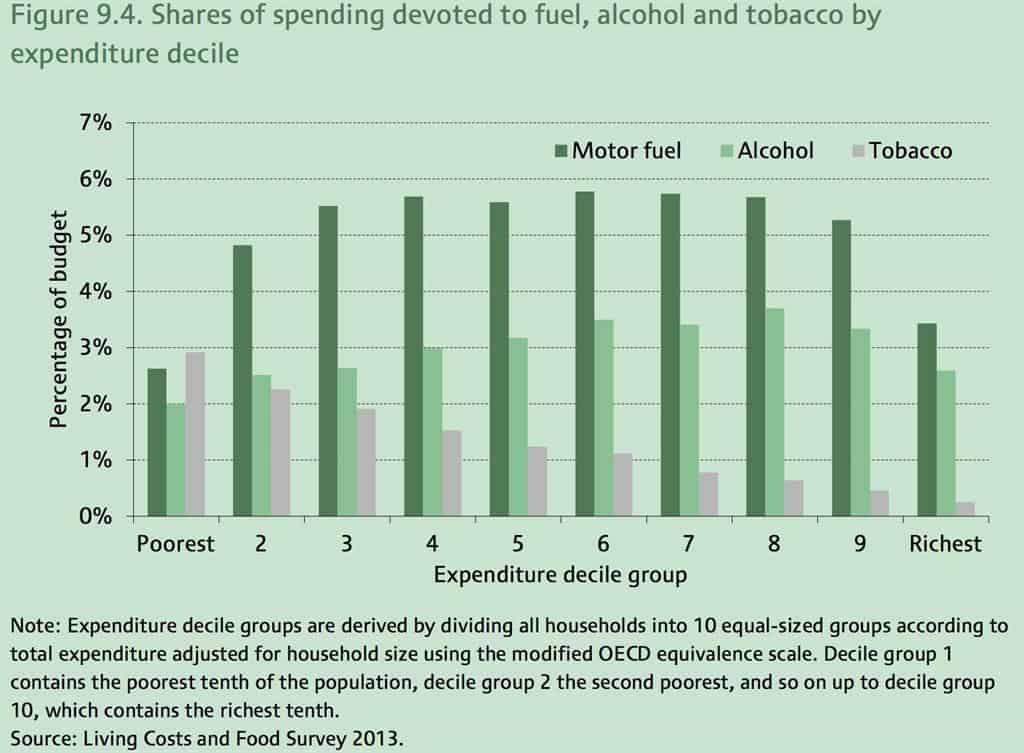
What can be done?
“The structure of alcohol excise taxes is partly restricted by an EU Directive that sets out that the tax base for wine and cider should be the volume of liquid, whereas the base for spirits and beer is the alcohol content. This places legal constraints on what the government could legally undertake,” the report’s authors claim.
Nevertheless, within these constraints, IFS suggests that the system could better target problem drinking. Tax reform that increases taxes on high-strength products (especially spirits) would target heavy drinkers “without falling foul of EU law”. The IFS also claims that “sensible tax reform may well do a more effective job at targeting harmful alcohol consumption than minimum unit pricing”, but that this depends “on how consumer price responsiveness for alcohol varies both across consumers with different levels of consumption and across different types of alcohol.”
Listen to one of the Green Budget report’s authors, Kate Smith, discuss alcohol taxes in our Alcohol Alert podcast: https://soundcloud.com/instalcstud
Minimum unit pricing best for reducing health inequalities, say Sheffield experts
A minimum price of 50p per unit of alcohol would be more effective in reducing health inequalities and cutting consumption among heavy drinkers than increases in current alcohol taxes
Minimum unit pricing and taxing all alcohol by strength are the best approaches for targeting a reduction in health inequalities of alcohol consumption, according to a comparative analysis of alcohol pricing strategies published in PLOS Medicine.
Using their well-known Alcohol Policy Model, the Sheffield Alcohol Research Group were able to estimate the impact of four different economic policies on alcohol consumption and health. Their findings showed that a minimum unit price of 50p was estimated to reduce consumption among low income heavy drinkers by 7.6% and low income moderate drinkers by 2.9%. Replacing current excise duties with a flat rate of £0.22 per unit of strength for all beverage types (volumetric taxation) was the next most effective policy, estimated to reduce consumption among low income heavy drinkers by 5.8% and low income moderate drinkers by 3.1%.
These results were in contrast to simply increasing current alcohol taxes to the equivalent level (13.4% increase), which was estimated to reduce consumption among both low income heavy drinkers and moderate drinkers by 2.2%. The least effective method was to introduce a 4% ad valorem tax to alcohol prices (specific sales tax on product value after duty at the time of purchase), which was estimated to lower consumption among both sets of drinkers by 2.1%.
In terms of reducing mortality among the heaviest drinkers and reducing alcohol-related health inequalities, the research team found that minimum unit pricing had the greatest impact on consumption among heavy drinkers on low incomes who are at greatest risk of harm from their alcohol use.
Among heavy drinkers in the lowest socioeconomic group, the estimated effects on mortality rates were −3.2% for the current tax increase (as in alcohol-related deaths fell by 3.2%), −2.9% for value-based taxation, −6.1% for strength-based taxation, and −7.8% for minimum unit pricing.
As a result of these targeted effects, these policies were also the most effective in reducing the gap in alcohol-related deaths rates between the lowest and highest socioeconomic groups, the authors of the study wrote.
“The alcohol-related mortality rate was 108% higher in lower socioeconomic groups before introducing any policy but this gap was estimated to reduce to 79% higher under a 50p minimum unit price and 83% higher when taxing all alcohol by strength,” they said.
The study contributes to an area of alcohol policy where evidence is needed for comparing the health impacts of different taxation and pricing strategies, including taxation by price, by beverage volume, or by alcohol content, and across population groups.
Commenting on the implications of their findings for the long-running minimum unit pricing court battle between the Scottish Government and a consortium of industry players led by the Scotch Whisky Association, the authors wrote:
“Our comparison of minimum pricing to tax policy options is fundamental [to the legal case], as it shows that whilst with substantial duty increases, the same overall reductions in deaths and hospital admissions could be achieved, these would not target heavy drinkers as effectively, lead to greater consumer spending increases and be less effective at reducing health inequalities.”
‘Estimated effects of different alcohol taxation and price policies on health inequalities: A mathematical modelling study’ was published in PLOS Medicine.
Number of alcohol-related deaths creeps upwards
Official figures show UK deaths among women hit highest level since 2008
The latest Office for National Statistics (ONS) report, ‘Alcohol-related deaths in the UK, registered in 2014’, found a 3% increase in the annual number of alcohol-related deaths (8,697 deaths; 14.3 deaths per 100,000), compared with the previous year (8,416 deaths; 14 per 100,000), the largest occurring among females (6%, compared with 2% males).
The ONS summary states that in the UK as a whole, alcohol-related death rates have fallen since peaking in 2008, but the most recent year’s mortality rate is still higher than that observed twenty years ago (below).
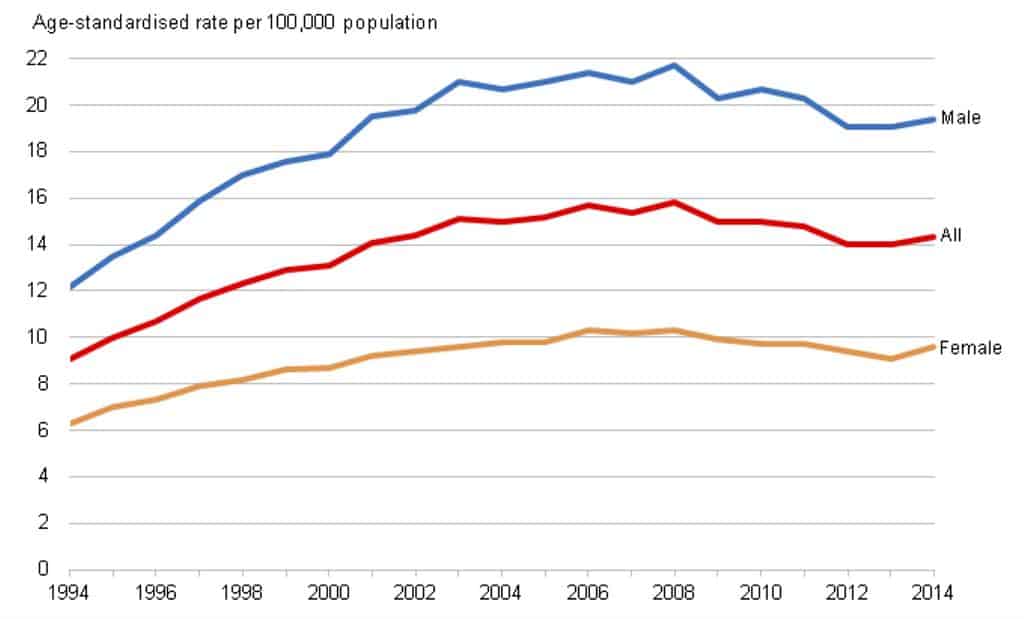
Similarly, although the broad picture shows that the majority of alcohol-related deaths (65%) in the UK in 2014 were still among males, the number of female deaths in the UK was at its highest level for six years (3,010 deaths, illustrated below). There was a 6% increase in alcohol-related deaths among females and a 2% increase among males.
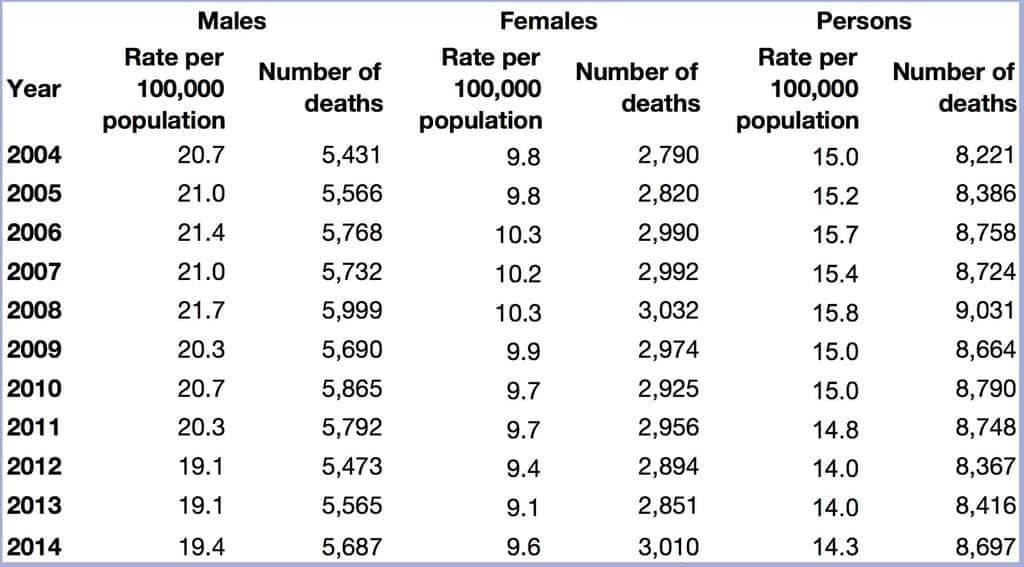
The annual number and rate of deaths among females also increased in all four Home Nations on last year, whereas it has fallen slightly for men in Wales and Northern Ireland.
Regionally, the data showed little change. For both sexes, Scotland had the highest alcohol-related death rates in 2014, but Scotland has also seen the fastest decrease in its rates since they peaked in the 2000s. Alcohol-related death rates for both sexes were significantly higher in the north of England than the south in 2014.
Alcohol deaths most common among middle-aged
In 2014, age-specific rates for men were highest among those aged 60 to 64 years (47.6 deaths per 100,000 men) and lowest among 25 to 29-year-olds (1.8 per 100,000). For women, rates were highest among 55 to 59-year-olds (22.1 per 100,000) and lowest among 25 to 29-year-olds (1.1 per 100,000).
The health effects of alcohol consumed during a drinker’s life appear most likely to have the greatest influence on those in middle age. Commenting on the results from their time series, the ONS report observes: “In each year between 1994 and 2014, the age-specific rate for alcohol-related deaths increased steadily with age, before generally peaking among those in their fifties or sixties. The rate then fell in subsequent age groups and, in some cases, the oldest age groups from 75 years upwards had rates similar to those in their forties.”
Public Health England (PHE) – who will release their Local Alcohol Profiles England report update in March – saw the figures as yet further evidence that more needs to be done around reducing the harms from alcohol. Professor Kevin Fenton, Director of Health and Wellbeing at PHE said:
“With over 10 million people in England drinking too much it is no surprise that deaths from alcohol continue to be far higher than ten years ago.
“Alcohol harms individuals, families and communities and it’s crucial that, alongside effective local interventions and treatment for those that need it, we look more widely at what affects drinking behaviour in this country, such as marketing and pricing.”
Number of drink-drive deaths at a crossroads
No significant change since 2010; a lower drink-drive limit will “break the deadlock”, urge road safety campaigners
The second provisional drink-driving dataset for 2014 produced by the Department for Transport has hinted that the number of people killed and seriously injured on British roads as a result of drink-driving has stalled since 2010. This follows increasing pressure to lower the drink-drive limit, currently in the form of a Bill that has passed its second reading in the House of Lords.
‘Reported road casualties in Great Britain: Estimates for accidents involving illegal alcohol levels: 2014’ shows that between 210 and 270 people were killed in accidents in Britain where at least one driver was over the drink-drive limit, with a central estimate of 240 deaths (illustrated). The figure is unchanged compared with the final figure for 2013, following a period of stability since 2010. It also represents about 14% of all deaths in reported road accidents in 2014.
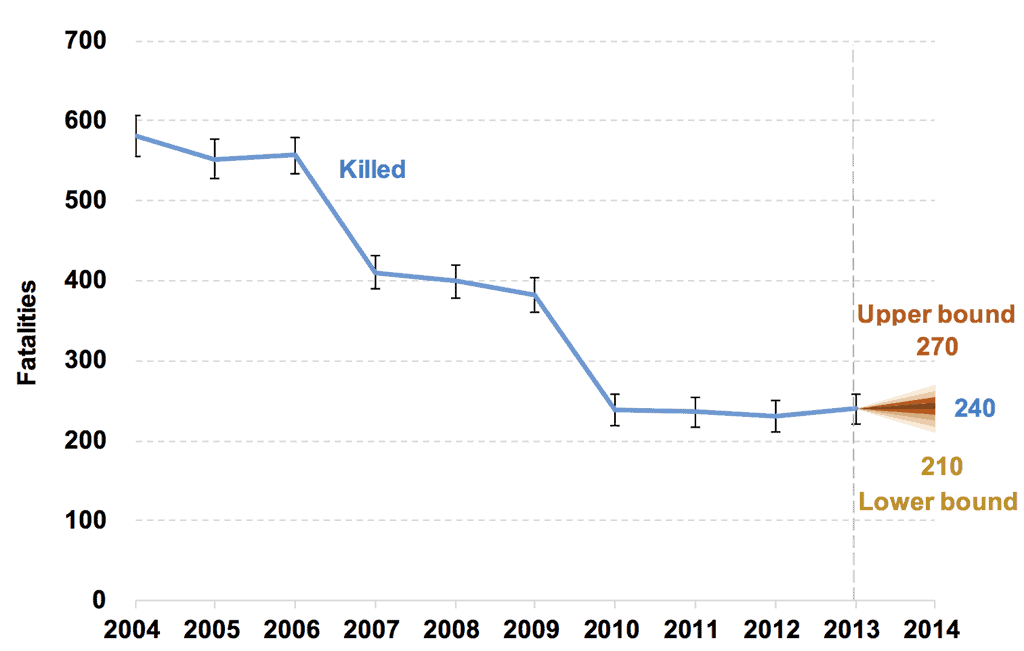
The number of seriously injured casualties in drink-drive accidents fell by 2% from 1,100 in 2013 to 1,080. If final estimates confirm this figure later on in the year, it will be the lowest number of seriously injured casualties on record. The provisional estimates for 2014 also show that the total number of casualties of all types in drink-drive accidents is 8,220, down 1% on the 2013 figure, and the total number of drink-drive accidents of all severities fell by 1% to 5,620.
Plateauing effect
When questioned on drink-driving, the current government has often repeated that it employs a tough position on drink-driving, with severe penalties imposed upon those caught doing so. In a recent House of Lords debate on the prospect of lowering the drink-drive limit (currently at the Committee Stage), Lord Ahmad of Wimbledon (Parliamentary Under-Secretary of State, Department for Transport) championed several government policies, including: making it a requirement for drink-drivers to undertake medical tests to ensure that they are not still dependent on alcohol before they are allowed to drive again; removing the so-called statutory option that allowed those drivers who provided a breath test that was slightly in excess of the prescribed limit to demand a blood or urine test; and removing the requirement for police to do a preliminary test by the roadside if they use a mobile evidential breath-testing device, thus paving the way for the introduction next year of more efficient mobile evidential breath-testing instruments.
However, with the number of those killed or seriously injured levelling off in recent years – even the proportion self-reporting drink-drivers has stayed constant (approximately 6-7%) since 2010/11 (source: ras51101a) – road safety campaigners have argued for the Government to take the already strict enforcement of road safety rules to the next level, by lowering the drink-drive limit from 80mg alcohol per 100ml blood to 50mg alcohol/100ml blood, in line with Scotland and most other European Union countries. Recent polls published by both the UK Alcohol Health Alliance (AHA) and road safety charity the Institute of Advanced Motorists found that lowering the drink-drive legal limit to 50mg/100ml is supported by an overwhelming majority of the British public (77% and 70% respectively).
Neil Greig, IAM director of policy and research, said: “The latest drink-drive statistics show that Britain is flat lining on drink-drive deaths. Total numbers of drink-drive accidents have gone down slightly but 20 people still die every month in an alcohol related crash – this is simply unacceptable.
“The government has increased the powers of the police to make it more difficult to avoid detection but they continue to avoid the one simple measure that could deliver fewer deaths immediately. That is of course a lower drink-drive limit in line with Scotland. “We need to break the deadlock on drink-drive deaths and a lower limit would send the strongest possible message that taking alcohol and driving is totally socially unacceptable in 2016.”
Professor Sir Ian Gilmore, chair of the Alcohol Health Alliance, said: “These figures show the significant harm done, both in terms of deaths and injuries, by drink-driving in the UK.
“It is worrying that the fall in the number of drink-drive deaths has stalled, particularly when we know exactly what we need to do in order to reduce the number of fatalities. A large part of the solution is to reduce the drink-driving limit from 80mg alcohol/100ml blood to 50mg/100ml, something which Scotland has already done. Every other country in Europe, except Malta, has a limit at this level or lower and by reducing the limit in this way, over a hundred lives would be saved each year, and many more injuries would be prevented. While a small fall in non-fatal alcohol-related injuries is welcome, we cannot be complacent when we know that a simple measure that would bring us into line with the rest of Europe would prevent many more.”
Updated 2014 final estimates for casualties in reported drink-drive accidents will be published in August 2016.
Dame Sally Davies defends new alcohol unit guidelines
England’s CMO wants all drinkers to ask themselves, ‘do I want the glass of wine or do I want to raise my risk of breast cancer?’
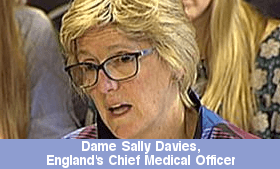 In the wake of the new alcohol unit guidelines published by the UK CMOs at the beginning of 2016, CMO for England, Dame Sally Davies, was called in front of the Science and Technology Committee to give oral evidence on the Work of the Chief Medical Officer.
In the wake of the new alcohol unit guidelines published by the UK CMOs at the beginning of 2016, CMO for England, Dame Sally Davies, was called in front of the Science and Technology Committee to give oral evidence on the Work of the Chief Medical Officer.
Facing questions from a panel of MPs led by Graham Stringer (Labour), Dame Davies explained the purpose of the changes made, which included lowering the weekly recommending maximum units for men to that of women (down from 21 units in a week to 14):
“The role of guidelines is to inform people, including the public, patients and clinicians, so that you can have a constructive discussion and they are aware of the issues. This is the first time any country has done a major review of the science in Europe in over 20 years. Australia and Canada did good, big reviews three or four years ago, and we have ended up in much the same place – that the science has moved on.
“The scientific group that advises the four CMOs advised that we should go for telling the world – our world – that we had low-risk guidelines: that is, a 1% risk of dying related to alcohol. Remember it is advice, not an instruction, and I would be done if I did not tell people the science. I have to tell the truth and make sure it is out there. It should be 14 units spread over a few days for both men and women.”
Probing further, the MP for Blackley and Broughton asked: “You said very clearly that it was to inform. Is it also to influence?”
Dame Sally Davies: “I hope it influences. We know that 25% of people drink over those guidelines; we know that two-thirds of people drink at home, and many of those are in that 25%. I would like people to make their choice knowing the issues, and do as I do when I reach for my glass of wine and think, “Do I want the glass of wine or do I want to raise my risk of breast cancer?” I take a decision each time I have a glass.”
He also brought up a point of dispute raised by the Royal Statistical Society over the so-called “protective effect” of alcohol.
Graham Stringer: “When you published the proposals, both the president and the president-elect of the Royal Statistical Society wrote to you to complain about the guidelines. They said they did not accurately reflect what the expert group had been advising you. What is your response to that complaint?”
Dame Sally Davies: “They looked at the protective effect called the J-shaped curve. They looked at that out of context with other issues. From the picture, they concluded that at one unit a day – half a standard glass of wine – there was a very small overall benefit for men and a larger overall benefit for women. I do not know many men who drink half a glass of wine every day.
“In discussion with the guideline group, we looked not only at those curves but at the short-term harms that impact men particularly… in England every year there are nearly 1,000 deaths related to alcohol –acute suicides – from intentional self-harm, of which 840 are in men. Therefore, we have to balance the J-shaped curve, which is half a glass of wine a day, with the short-term and long-term effects. That is why, between all of us, we came to the conclusion that for women aged over 55 drinking up to five units in a week there is some cardio-protective effect. By the time they drink more than five units and get to 14 units, which is the recommended lower risk upper level, they have lost that cardio-protective effect.”
Dr Tania Mathias, Conservative MP for Twickenham, pressed Dame Davies for her thoughts on the issue of calorie labelling, asking what evidence there was for compulsory labelling of alcoholic beverages impacting on behaviour:
Dame Sally Davies: “I do not believe there is much evidence. Alcoholic drinks are currently exempt from this under European law. Some businesses have chosen voluntarily to label calories. It is under discussion at EU level, but I am not aware of actual evidence.”
Dr Mathias: “There is no evidence as to what effective calorie labelling on alcohol would achieve or not achieve.”
Dame Sally Davies: “I would like to test it and see, but that is a personal opinion. It would be worth testing.”
Dr Mathias: “That is a research project that you would advocate.”
Dame Sally Davies: “Potentially. Someone may bid to do exactly that.
“… Alcohol manufacturers and supermarkets have labelled quite a lot – I think it is about 90% – of alcohol that is on sale. The trouble with a lot of that labelling is that it is terribly small. The label for pregnancy is not terribly visible. I would like to see it larger and clearer.”
Dr Mathias: “Would you advocate a research project on behaviour? Do you think that is possible?”
Dame Sally Davies: “You can do research on everything. We have limited money and we have to choose which we are going to do, if someone puts forward a good proposal. The trouble is that you would probably need quite a big study.”
Cheltenham Borough Council vote to phase out late-night levy
Councillors may replace crime and social disorder measure with business-friendly scheme
The second ever council in the UK to introduce the Late Night Levy (LNL) may replace the charge with a Business Improvement District (BID) fee for licensed venues. The Leader of Cheltenham Borough Council (Cllr Steven Jordan, All Saints) and his cabinet members held a meeting where they took the view that a BID fee would be of greater benefit to the town than a LNL.
Cheltenham Borough Council introduced a levy in April 2014, which required licensed premises operating between midnight and 6am to contribute between £299 and £4,400 towards improving and policing the late-night economy, depending on the rateable value of the premises.
The council originally hoped 218 licensed premises would pay the levy, but it only affected 123 due to venues changing hours and operators handing in their licences. As a result the council collected £76,889 in its first year – less than half the expected £199,000 – according to the findings of a Freedom of Information request made by Poppleston Allen.
Jonathan Smith, Poppleston Allen partner, said: “The amount the Council made from the levy was very small, much smaller than other levies in the country. The BID will make far more money, and is spread between businesses.
“A proportion of the levy is supposed to be spent on issues in the late-night area, and 70% goes straight to the police, which won’t be the case with a BID,” he added.
The introduction of the BID – subject to agreement from local companies and traders later on in the year – could see businesses in central Cheltenham pay an extra 1.25% of their business rates to fund schemes to attract more commerce to the town.
The Council said money taken from a BID would ‘far exceed’ that of a levy. “If businesses vote for the bid then we will drop the Late Night Levy,” Steve Jordan said.
In the first year, the sum paid in levies would be deducted from their BID charge. The levy would then be scrapped altogether from April 2017.
New survey reveals 1 in 6 Brits went Dry this January
Adapted from Alcohol Concern press release
New data released by charity Alcohol Concern show that nearly 1 in 6 Brits attempted a Dry January this year (16%). The 2016 figures show just how popular and culturally embedded Alcohol Concern’s campaign, that encourages people to take the first month of the year off alcohol, has become. These figures are backed up by the initial economic data showing people swapping spend to soft drinks and non-alcoholic drink options over alcoholic drinks.
The YouGov survey of British adults reveals that of those that attempted Dry January, 71% succeeded the whole 31 days with no alcohol.
The figures also show that women were both more likely to take on Dry January and succeed in completing the month compared to men (75% of women who attempted a Dry January succeeded without alcohol, compared with 67% of men).
Tom Smith, Director of Campaigns at Alcohol Concern, said: “In only four years, Alcohol Concern have succeeded in making Dry January a household name, with millions going dry for January.
“The response we’ve had to the campaign is overwhelming. People tell us that having a Dry January has helped them to break bad habits and to kick start a new relationship with alcohol.
“Successful participants tell us they feel great and more in control, enabling them to reduce their drinking all year round. Most of those that fall off the wagon get back straight back on, and go on to feel many of the health benefits of a break.
“Our behaviour change campaign gives people a great excuse and the confidence to say no to booze and to carry on saying no, if that’s what they want, once January is over.”
The campaign also went international in 2016, with people from 94 different countries signing up Alcohol Concern’s campaign. Early research from Alcohol Concern into the main motivations to do Dry January showed people took part to:
- Lose weight
- Have more energy
- Save money
Further research will be conducted throughout the year to look into the behaviour change in participants after completing the 2016 campaign. Last year Alcohol Concern and Public Health England found that 67% of participants had cut down their drinking after Dry January, 8% of which stayed dry.
All figures, unless otherwise stated, are taken from a YouGov poll with a total sample size of 2,091 adults, interviewed from 3rd – 4th February 2016. Dry January is Alcohol Concern’s annual campaign (since 2012) challenging people to go booze free for 31 days. In 2016, the campaign received record levels of attention, including 168,376 visitors to the Dry January website.
Teenagers with lowest levels of parental control ‘heaviest drinkers’
Analysis of a decade’s worth of data also reveals link between alcohol use and secrecy
A study of adolescents’ drinking habits has found the heaviest consumers of alcohol were teenagers under the lowest levels of parental control. The biggest drinkers among the 11 to 17-year-olds were also most secretive about their use of alcohol.
Researchers from Glasgow University and Queen’s University Belfast analysed data from 4,937 secondary school students from Northern Ireland (48 : 52 male-to-female ratio) between 2000/2001 and 2006/2007, as part of the Belfast Youth Development Study – a survey observing adolescent substance use. This was repeated once more 10 years after the first sweep (2011).
The results of the study – based upon data from its first five years – suggest that the determining factor in alcohol use is not the quality of the relationship between parent and child, but the level of control exercised by parents.
The main findings were:
- Higher levels of parental monitoring were associated with less frequent use of alcohol
- More frequent adolescent alcohol use was associated with lower parental control
- Alcohol use was associated with lower levels of child disclosure
The strongest association found across any of the models was the association between alcohol use and subsequent levels of child secrecy.
Dr Mark McCann, from the MRC/CSO Social and Public Health Sciences Unit at Glasgow University, said: “Our results suggest the role of parents in determining alcohol behaviour is consistently important” and that support for adolescent parenting “may be a more beneficial target for public policy aimed at young people’s behaviour.”
‘Assessing elements of a family approach to reduce adolescent drinking frequency’ is published in the journal Addiction.
More action needed on alcohol policy at EU level
Government welcomes Lords recommendations, but remains tight-lipped on next moves
Crossbencher Baroness Prashar led calls from peers for the UK Government to apply more pressure on the European Union (EU) towards alcohol policy during a Lords Committee meeting discussing the House of Lords European Union Committee report, A New EU Alcohol Strategy?.
She began the session by stating that there is considerable scope for action to be taken at the EU level that is within its competence, but that action is worth formulating only to the extent that it supplements and supports what member states do independently. This sentiment was echoed by other peers, including crossbencher Baroness Murphy, who, despite her connections with the brewery sector, remarked that it was “a disgrace that it [the EU] does not have a strategy to which we can all subscribe, and which makes best sense of what it and individual states can do.”
Baroness Prashar went on to criticise the EU’s alcohol taxation regime, calling the current relationship between alcohol strength and duty “illogical”, and asked what steps the government was taking to consider introducing minimum unit pricing.
She also suggested that the government adopt a “health in all policies” approach in related areas such as food labelling, cross-border marketing and competence of member states in health matters.
“This would bring greater coherence across EU policy areas while respecting the competence of member states in health matters,” she said.
Prashar was concerned at the apparent lack of urgency in pressing the Commission to propose amendments to the food labelling regulations to include information on strength and calorie content, safe drinking, and the dangers of drinking during pregnancy. Comparing the UK’s progress to other member states, she said: “The regulations are already sufficiently flexible to allow member states to impose such rules domestically, and France has done so.”
Responding on behalf of the UK Government, Lord Prior of Brampton (Parliamentary Under-Secretary State for the Department of Health) said that he broadly agreed with the report’s recommendations.
He said that the government “will be putting what pressure they can” on the EU to tax alcohol proportionally. However, on minimum unit pricing, Lord Prior could only say that minimum unit pricing was being kept “under review” and the current legal challenge in Scotland was being monitored closely.
He also stated that the government remained committed to working with industry to address concerns over irresponsible promotions, and defended the Responsibility Deal’s so-called achievements, namely that “just under 80% of bottles and cans of alcohol were assessed to have the correct health labelling” (i.e. clear unit content, the CMO’s lower-risk drinking guidelines and a warning about drinking when pregnant).
He said: “The possibility of mandating nutritional labelling, including calories and ingredients labelling on alcohol, is still under discussion at EU level.” In the meantime, the UK had secured a provision to allow voluntary calorie labelling, which businesses including Sainsbury’s, Co-op, and Waitrose, are already using.
SHAAP create ‘Top Twenty’ Manifesto for Action on Alcohol plan
NGO in call for further action on alcohol availability and marketing to reduce alcohol-related harm
SHAAP (Scottish Health Action on Alcohol Problems) has written personally to all Members of the Scottish Parliament in advance of the 2016 Holyrood elections, laying out its ‘Top Twenty’ recommendations for action on alcohol. These recommendations mark SHAAP’s renewed commitment to work with partners to prevent and reduce alcohol- related harms.
Reducing alcohol-related harm in Scotland remains a priority for several reasons, including:
- Scotland has one of the highest liver cirrhosis mortality rates (a marker for alcohol-related harm) in Western Europe
- Alcohol death rates in Scotland are almost twice the level they were in the early 1980s
- Twenty Scots die every week because of alcohol
- Hospital admissions for alcoholic liver disease have more than quadrupled in the past 30 years.
Eric Carlin, Director of SHAAP, said:
“After several years of welcome reductions in alcohol-related hospitalisations and harms, these are both on the increase again. It is vital that alcohol policy in Scotland should be aligned to the WHO’s ten ‘Best Buy’ recommendations, with a specific focus on increasing the price of the cheapest, most harmful products and taking action to restrict the availability and marketing of alcohol. SHAAP’s Top Twenty recommendations should be regarded as an entire package, including health interventions such as Alcohol Brief Interventions (ABIs).”
Dr. Peter Rice, Chair of SHAAP, said:
“We represent health professionals who are in the frontline, dealing with the problems that alcohol causes to individuals and communities on a daily basis. There has been much good work in Scotland in recent years in prevention and in helping individuals and families, but much remains to be done. Some of this work will be to progress existing policies, in particular Minimum Unit Price, which has been delayed by the actions of global alcohol producers. There are other new actions, for instance, on licensing and the way alcohol is sold, which we are keen to see introduced.”
Responding to the publication by SHAAP (Scottish Health Action on Alcohol Problems) of its ‘Top Twenty’ recommendations for action on alcohol, Alison Johnstone, Health and Wellbeing spokesperson for the Scottish Greens and MSP for Lothian, said:
“The recommendations from SHAAP are welcome and I’m confident that health campaigners will be encouraged by the Scottish Greens manifesto when it is published in the coming weeks. As well as supporting Minimum Unit Pricing we have consistently questioned how healthy it is that a handful of big businesses – whose motives are all about profit – control our drinks industry.”
Councils need more powers to limit new alcohol premises
Limit the opening of late-night premises in areas where there are worries about the impact of alcohol on public health
A new survey by the Local Government Association (LGA) reveals nearly 90% of council health chiefs want a public health objective included in a revamped Licensing Act to help curb the saturation of communities with pubs, clubs and off-licences selling alcohol.
It also emphasised how councils need greater access to NHS data, including hospital admissions and ambulance call-out details. Under current rules, local councils can consider health-related issues, but only as they relate to the four licensing objectives (prevention of crime and disorder; protection of public safety; the prevention of public nuisance; and protection of children from harm). This is an unhelpful process, which leaves only limited scope for health concerns. The addition of a health objective would simplify this process.
Latest figures show alcohol-related hospital admissions in England have more than doubled over 10 years – to more than a million – with excessive alcohol consumption estimated to cost the NHS around £3.5 billion per year. In 2014, there were 8,697 alcohol-related deaths registered in the UK.
Councils are responsible for running local alcohol prevention schemes but are seeing public health budgets cut by £331 million over the next five years.
The LGA said the public health funding issues makes it even more important for government to ensure local authorities have the same powers as those in Scotland which have been able to consider all health implications – such as hospital admissions and local addiction levels – in relation to licensing applications since 2005. Councils are also calling for greater access to NHS and crime data to help create ‘alcohol harm’ maps.
A public health criteria within the Licensing Act would give councils greater power to protect local communities from the spread of alcohol outlets and irresponsible promotions, make greater use of indicators of long-term health harm and reduce NHS costs.
Cllr Tony Page, Licensing spokesman on the LGA’s Safer and Stronger Communities Board, said:
“Obviously councils are not seeking powers to refuse every application – the social benefits of moderate drinking are well documented – but it would certainly allow them to take a more balanced view in line with their other priorities such as creating vibrant and safe town centres and protecting people from harm.
“Councils can listen to health evidence, but are powerless to refuse, new licences on public health grounds. Then after granting permission, they will have less money to spend on prevention schemes such as tackling alcohol misuse.
“Alcohol is a significant public health issue in many areas and having new licensing powers to protect and improve public health would allow councils to fully take into account the social and health impacts on their local communities as well as help reduce NHS costs.”
New parliamentary campaign aims to break the silence over alcoholism
MP launches bid for new law to help Children of Alcoholics
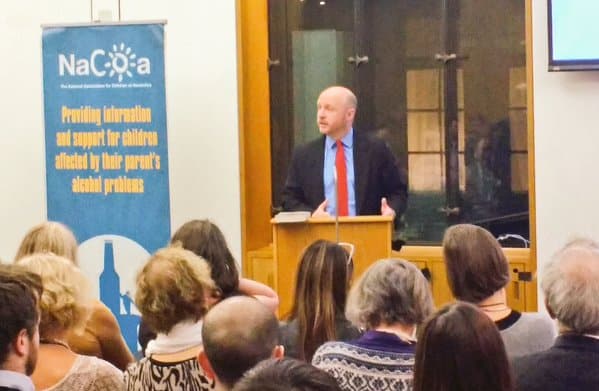 Liam Byrne announced the publication of the Children with Alcoholic Parents (Support) Bill during a speech delivered to the National Association of Children of Alcoholics (NACOA).
Liam Byrne announced the publication of the Children with Alcoholic Parents (Support) Bill during a speech delivered to the National Association of Children of Alcoholics (NACOA).
Addressing a packed audience at the 25th annual David Stafford Lecture at Portcullis House, the MP for Birmingham Hodge Hill spoke of his personal battle with his father, who succumbed to alcoholism, the experience of Children of Alcoholics (COA).
The speech marked the start of Children of Alcoholics Week, which succeeded the launch of the All-Party Parliamentary Group on Children of Alcoholics. Publicised on BBC News, the group’s new campaign calls for publicity aimed at heavy drinking parents, a national strategic plan with a government minister in charge, and more money for helplines, in response to the diminishing levels of provisions for COAs. NACOA found that despite the increases in alcohol-related hospital admissions, almost no local authority is increasing its drug and substance misuse treatment budgets, and over a third are cutting them.
Liam Byrne’s Ten Minute Rule Bill states:
“That leave be given to bring in a Bill to make provision about the care and support of children with one or more alcoholic parents; to provide for the allocation of a duty to coordinate specified health and social services to a specific Minister; to establish a national strategy and a system of annual reporting of performance by local authorities against relevant objectives and targets within such a strategy; to oblige local authorities to provide specified other data on children with one or more alcoholic parents in their area; and for connected purposes.”
Alcohol sports sponsorship linked to risky drinking
Study shows increased risky drinking amongst schoolchildren and adult athletes exposed to alcohol sports sponsorship
A new international study adds to a growing body of evidence that has found an association between alcohol sponsorship of sport and risky drinking amongst schoolchildren and adult athletes in recent years.
Published in the journal Alcohol and Alcoholism, this systematic review combines evidence from the UK and other countries on the impact of exposure to alcohol sports sponsorship on drinking behaviours.
Seven studies were included in the review that presents findings from 12,760 people in high-income countries including the UK, Australia and New Zealand. All the studies indicate that exposure to alcohol sports sponsorship is associated with increased levels of alcohol consumption and risky drinking amongst schoolchildren and sportspeople.
Two of the studies were conducted in the UK. Their findings were:
Amongst Welsh schoolchildren in Year 10 (age 14-15), awareness of alcohol sports sponsorship was linked to a 17% higher chance of boys, and 13% higher chance of girls, getting drunk at the weekend. When the same schoolchildren had both positive attitudes towards alcohol and awareness of alcohol sports sponsorship, the chances of getting drunk at the weekend were 26% higher for boys and 27% higher for girls.
Amongst UK university sportspeople, those receiving alcohol industry sponsorship were four times more likely to report hazardous drinking than non-sponsored sportspeople.
The report also includes a study of schoolchildren aged 13-14 from four European Union (EU) countries, which found exposure to alcohol sports sponsorship through viewing a major football tournament was linked to a 70% increased chance of underage drinking.
The report’s author, Katherine Brown, is Director of the Institute of Alcohol Studies. She said:
“It is of great concern to see that sport, which should be viewed as a healthy, family friendly activity, is potentially putting our children and athletes at risk due to sponsorship deals with alcohol companies.
“There is strong evidence that exposure to alcohol marketing leads young people to drink at an earlier age and to drink more if they already do so. This is why the OECD and World Health Organisation have called on governments to investigate the introduction of alcohol advertising bans.
“Major alcohol brands are prominent in almost every high profile sporting event today, exposing millions of children to advertising and building positive associations that could be damaging in the long term.”
Podcast
Our monthly podcast features interviews with experts from across the sector.
How to shift the dial on alcohol policy in Europe
Florence Berteletti –
Eurocare
Anamaria Suciu –
Eurocare

